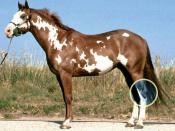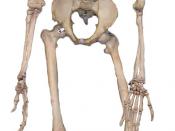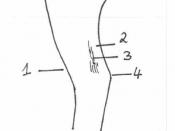The foreleg should be strong and well developed. A plumb line dropped from the center of the shoulder should go right down the center of the leg. (a) shows a good foreleg. If the leg is set too far back, it is called 'standing under'(b), which causes the horse's balance to be too far forward, and may make them more prone to stumbling. 'Camped out in front(c),' refers to a fault where the leg is in front of the line, which puts extra stress on the legs, especially the heels and flexor tendons. 'Over at the knee,' or 'buck knee(d),' when the knee is too bent, is sometimes connected with contracted tendons. Also, if its severe, it may cause stumbling. 'Back at the knee,' or 'calf knee(e),' is when there is a backward bend in the leg causing the cannon to slant forward. It puts a lot of extra strain on tendons, ligaments, bones and joints.
Chips and fractures, a bowed tendon, or other unsoundnesses are prone to happen under heavy work.
From the front, the legs should be parallel, and again, a plumb line dropped from the point of the shoulder to the ground should pass through the middle of the leg, as is shown in (a). 'Base narrow(b),' is a situation where the legs are closer together at the hooves than at the chest. This puts more concussion on the outside of the foot, and may lead to ringbone. The horse may also interfere, or 'rope walk,' where the feet are placed one after another instead of next to each other when the horse moves. 'Base wide(c),' as the name implies is when the legs are wider apart at the hooves than at the chest. There is more stress on the inside of the foot, and it may...



Sorry
the diagrams won't copy over and they are not in a seprate file
4 out of 5 people found this comment useful.